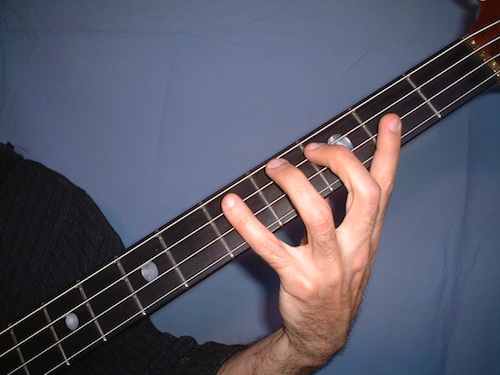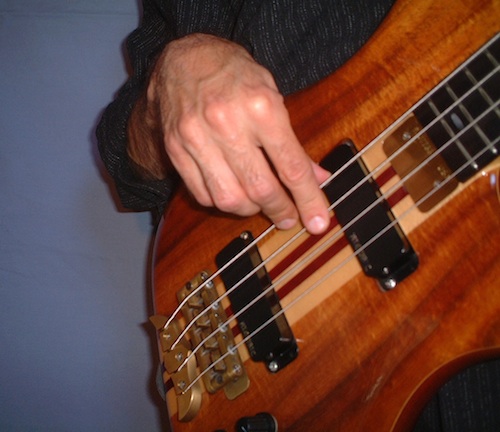Level: beginner
No part of this lesson may be copied, reproduced, or distributed in any form without consent of the author. Copyright © Doug Ross, all rights reserved.
Okay, so you’ve finally fulfilled your ambition to start playing bass. You went out and got yourself the essential starting equipment: a bass guitar, and amp and a cable. Now, which end do you blow into….?!? In this lesson, I’ll demonstrate how to hold the bass properly, and how to play it with a good sound.
In the beginning, I strongly suggest that you arrange to take at least a few lessons with an experienced pro bassist. It’s especially important to establish good technical habits in the beginning, to avoid potential injury. After that, it might be helpful to refer back to the images on this page from time to time, to double check that you’re keeping good form.
Whether you play standing up or sitting down, try to maintain traditional “good posture”. Your back should be straight, no hunching or leaning forward to look at the bass. The neck of the bass should be angled slightly upward, and neither wrist should be bent at an extreme angle. Here’s how the bass should look when you play standing up:

Adjust your strap short enough so that the strings of the instrument are higher than your waist. By simply resting your plucking arm on the upper bevel of the body, the bass should stay comfortably in this playing position, without needing to lift or support the neck with your fretting hand. Now here’s an example of good seated playing form:

Notice that the neck is still angled upward and the bass is in essentially the same position relative to the upper body as it was when standing. The bass should rest on your right leg (if you’re right handed), and you might need to prop your right leg up somewhat to achieve a comfortable playing height. Keep your back straight!
Now let’s look at each hand up close. As mentioned previously, the fretting hand should not be used to support the weight of the neck. The only necessary points of contact here are with the fingers, so don’t grasp the neck with your whole palm like a baseball bat. Maintain a natural arch to your fingers, so that you can press down the strings with your fingertips. Since you have four fretting fingers, the idea is to span four frets at a time, pressing down the fretting fingers immediately behind their respective frets. If you press down too far from the fret, your notes might buzz or rattle. In this photo, I’m fretting the third fret on the A string:

If spanning four frets is too difficult in the lowest positions, it is permissible to omit the ring finger, and just span three frets (index, middle, pinky). The thumb should counter the pressure of your fretting fingers from the center of the back of the neck, roughly opposite your middle finger. Don’t hook your thumb over the top of the neck, and keep your palm off of the neck.

Now on to the plucking hand. You will see pro bassists using lots of different techniques with this hand, but two finger alternation is probably the most common approach. Rest your thumb on the E string (the thickest string), roughly halfway between the bridge and the end of the neck. Now try plucking the adjacent string (the A string) with your index and middle fingers, alternating 1-2-1-2. Be sure to pluck from the pad of your finger, not just the fingertip. To get a good, full sound, you should drag the pad of your finger firmly across the string, and come to rest on the next lower (thicker) string.

You can now try fretting some notes on the A string with your other hand, to produce different pitches. Alternate plucking is pretty easy on just one string, but you might get confused when crossing strings, fretting one note while accidentally plucking the wrong string with the other hand. You’ll get over that pretty quickly, and soon you won’t have to look at your plucking hand at all when playing.
There are some other finer points to good technique, such as muting, string crossing, pick playing, etc. But this should get you started for now. Again, I recommend that you have an experienced bassist evaluate your technique from time to time. And if you experience any pain or chronic inflammation, that is your body telling you that you’re doing something wrong. Best of luck with your new instrument, and have fun!